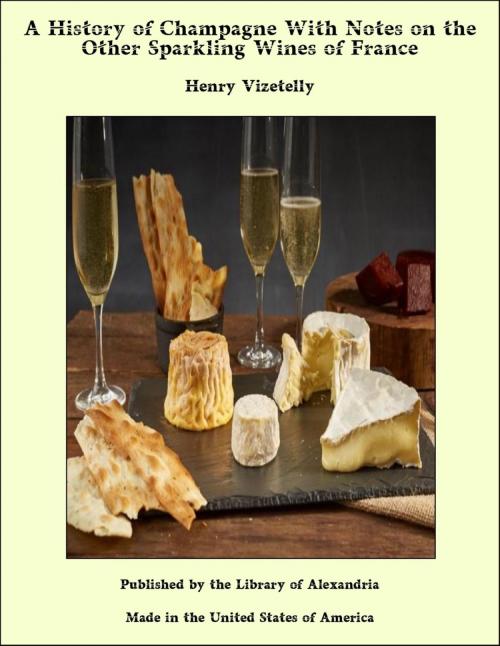A History of Champagne With Notes on the Other Sparkling Wines of France
Nonfiction, Religion & Spirituality, New Age, History, Fiction & Literature| Author: | Henry Vizetelly | ISBN: | 9781465623645 |
| Publisher: | Library of Alexandria | Publication: | March 8, 2015 |
| Imprint: | Language: | English |
| Author: | Henry Vizetelly |
| ISBN: | 9781465623645 |
| Publisher: | Library of Alexandria |
| Publication: | March 8, 2015 |
| Imprint: | |
| Language: | English |
ALTHOUGH the date of the introduction of the vine into France is lost in the mists of antiquity, and though the wines of Marseilles, Narbonne, and Vienne were celebrated by Roman writers prior to the Christian era, many centuries elapsed before a vintage was gathered within the limits of the ancient province of Champagne. Whilst the vine and olive throve in the sunny soil of the Narbonnese Gaul, the frigid climate of the as yet uncultivated North forbade the production of either wine or oil. The ‘forest of the Marne,’ now renowned for the vintage it yields, was then indeed a dark and gloomy wood, the haunt of the wolf and wild boar, the stag and the auroch; and the tall barbarians of Gallia Comata, who manned the walls of Reims on the approach of Cæsar, were fain to quaff defiance to the Roman power in mead and ale. Though Reims became under the Roman dominion one of the capitals of Belgic Gaul, and acquired an importance to which numerous relics in the shape of temples, triumphal arches, baths, arenas, military roads, &c., amply testify; and though the Gauls were especially distinguished by their quick adoption of Roman customs, it appears certain that during the sway of the twelve Cæsars the inhabitants of the present Champagne district were forced to draw the wine, with which their amphoræ were filled and their pateræ replenished, from extraneous sources. The vintages of which Pliny and Columella have written were confined to Gallia Narboniensis, though the culture of the vine had doubtless made some progress in Aquitaine and on the banks of the Saône, when the stern edict of the fly-catching madman Domitian, issued on the plea that the plant of Bacchus usurped space which would be better filled by that of Ceres, led (A.D.92) to its total uprooting throughout the Gallic territory.
ALTHOUGH the date of the introduction of the vine into France is lost in the mists of antiquity, and though the wines of Marseilles, Narbonne, and Vienne were celebrated by Roman writers prior to the Christian era, many centuries elapsed before a vintage was gathered within the limits of the ancient province of Champagne. Whilst the vine and olive throve in the sunny soil of the Narbonnese Gaul, the frigid climate of the as yet uncultivated North forbade the production of either wine or oil. The ‘forest of the Marne,’ now renowned for the vintage it yields, was then indeed a dark and gloomy wood, the haunt of the wolf and wild boar, the stag and the auroch; and the tall barbarians of Gallia Comata, who manned the walls of Reims on the approach of Cæsar, were fain to quaff defiance to the Roman power in mead and ale. Though Reims became under the Roman dominion one of the capitals of Belgic Gaul, and acquired an importance to which numerous relics in the shape of temples, triumphal arches, baths, arenas, military roads, &c., amply testify; and though the Gauls were especially distinguished by their quick adoption of Roman customs, it appears certain that during the sway of the twelve Cæsars the inhabitants of the present Champagne district were forced to draw the wine, with which their amphoræ were filled and their pateræ replenished, from extraneous sources. The vintages of which Pliny and Columella have written were confined to Gallia Narboniensis, though the culture of the vine had doubtless made some progress in Aquitaine and on the banks of the Saône, when the stern edict of the fly-catching madman Domitian, issued on the plea that the plant of Bacchus usurped space which would be better filled by that of Ceres, led (A.D.92) to its total uprooting throughout the Gallic territory.















